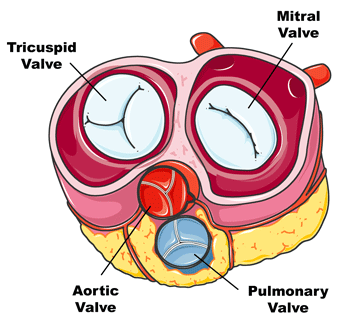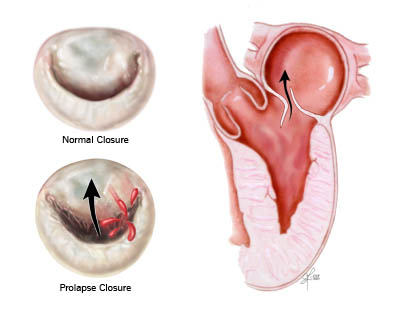Anatomy Of Heart Valve Disease, Disorders & Infections
The heart has four chambers. The upper two chambers are the right and left atria. The lower two chambers are the right and left ventricles. Blood is pumped through the chambers, aided by four heart valves. The valves open and close to let the blood flow in only one direction. Your valves are shown on the diagram below. The valve names are the pulmonary valve, the aortic valve, the tricuspid valve and the mitral valve.

What Do Your Heart Valves Do?
Again, it's critical to remember that your heart valves keep should keep blood flowing in one direction through your heart - just like the one-way valves in your home's plumbing. Your heart valves open to let blood flow through and then close to prevent blood from flowing back.
When a valve closes, flaps of tissue on the valve close tightly to create a seal. These tissue flaps are called leaflets. When working properly, the heart valves open and close fully so that blood keeps moving in one direction at all times.
The four heart valves can be grouped by their job:
- Atrioventricular valves control blood flow between your heart's upper and lower chambers. The valve between the right atrium and the right ventricle is called the tricuspid valve. The valve between the left atrium and the left ventricle is called the mitral valve.
- Semilunar valves control blood flow out of your heart. Blood flows out of the right ventricle to the lungs through the pulmonary valve. Blood flows out of the left ventricle to your body through the aortic valve.
Heart Valve Defects & Disease
Just like all physical things in life – your computer, your car, your DVD player – problems can occur with your heart valves. Sometimes, a person can be born with an abnormal heart valve, also known as a congenital heart defect. A common form of congenital heart valve defect is a bicuspid aortic valve. Other people may experience valve damage due to infections, rheumatic fever, calcification and changes in valve structure as we age.
Most problems associated with valve damage are associated with the opening and closing of the valve. If a valve fails to open all the way, less blood moves through to the next chamber. If a valve fails to close tightly, blood may leak backward.

These problems may mean that the heart must work harder to pump the same amount of blood out to the reset of the body. Alternatively, blood may leak back in the lungs or body because blood is not moving through the heart as it should.
- Problems opening - Stenosis. Valve stenosis occurs when a valve fails to open fully. The valve may have become hardened or stiff with calcium deposits or scarring. So, it's hard to push open. This is problematic because blood has to flow through a smaller opening, so less blood gets through the valve into the next chamber. Aortic stenosis is the most common form of stenosis.
- Problems closing - Regurgitation. Insufficient blood flow (also called regurgitation) results when the valve fails to close tightly. The valve's supportive structures may be loose or torn. Or, the valve itself may have stretched or thinned. This is problematic because blood will leak back through the valve into the heart. As a result, the heart must work harder to re-pump the blood through the heart. Mitral regurgitation is the most common form of regurgitation.
You Might Also Like
To help you learn about heart valve disease and treatment options, you may like:
- What is a Heart Murmur?
- What is an Enlarged Heart?
- How is Heart Valve Disease Diagnosed?
- What are the Different Types of Echocardiograms?
- Meet 1000s of Heart Valve Patients in Our Community
- Download 7 Free Educational eBooks for Patients Here
Page last updated: September 16, 2020




